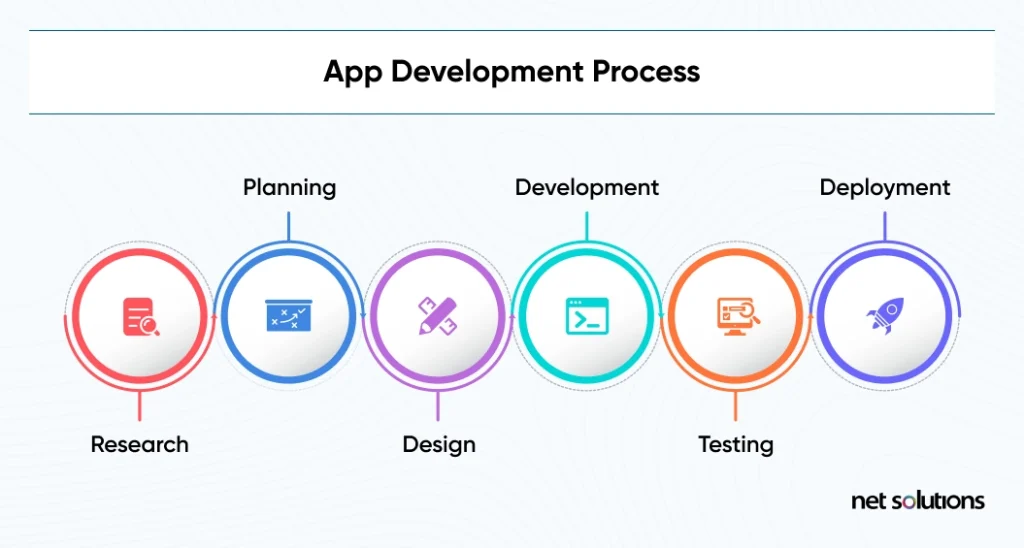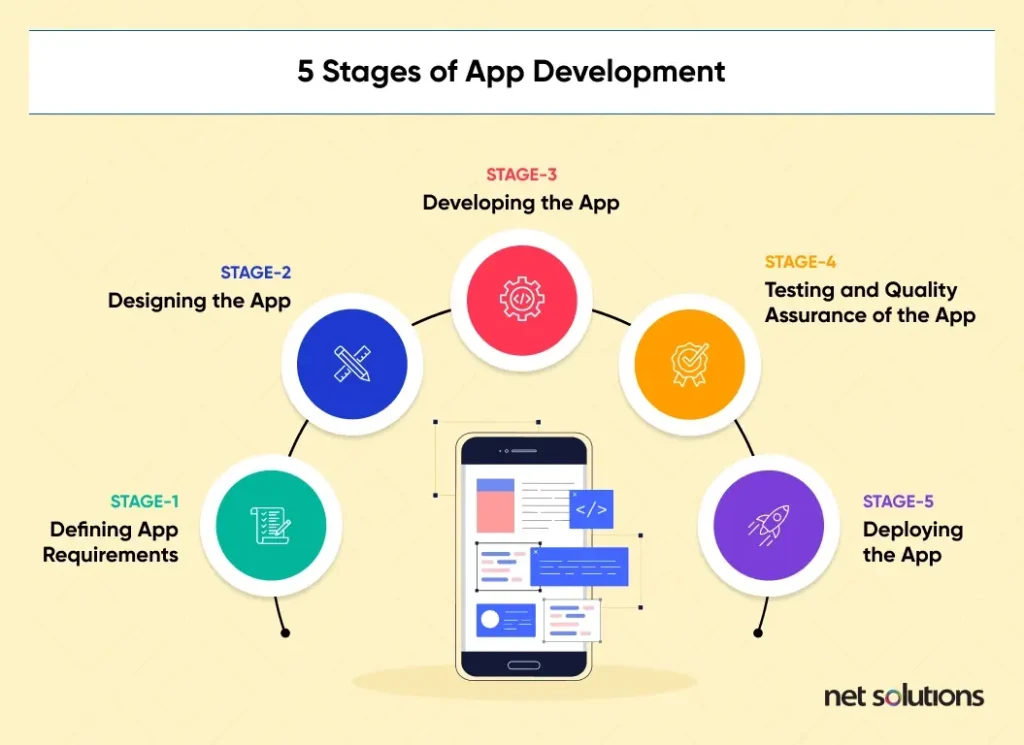Delve into the world of mobile app development with this comprehensive guide, outlining the five essential steps to create a successful app. Get a step-by-step roadmap and valuable insights for your app project. Explore the full article for in-depth expertise.
In a dynamic mobile app development market, your role as a business owner is not merely about creating apps; it’s a journey of innovation and excellence.
In this comprehensive guide, we’re about to embark on a transformative odyssey through the five pivotal stages of mobile app development. This is no ordinary venture; it’s a strategic expedition infused with a profound understanding of the digital landscape.
Mobile app development is one of the most exciting and profitable ventures in the digital economy. It has been a decade or more since app-based computing has hit it big, and mobile app development companies have refined the process to a firm set of steps.
You must also check a few mobile app development tips that can help you avoid common pitfalls and make your mobile app a success.
The App Development Process

The app development process is a structured journey consisting of several critical stages. Each stage contributes significantly to the overall success of your app.
- Research: This initial phase involves comprehensive market research, competitor analysis, and understanding user needs. It sets the foundation for your app by helping you identify gaps in the market and potential opportunities.
- Planning: In this phase, you create a roadmap for your app project. This includes setting clear goals, defining your app’s core features, estimating the cost to build the mobile app, and establishing a timeline. A well-thought-out plan serves as a guide throughout development.
- Design: Design is where the user experience (UX) and user interface (UI) come to life. It’s crucial to prioritize user-friendliness and visual appeal. The design phase includes wireframing, creating prototypes, and selecting design elements that align with your app’s identity.
- Development: This is the coding phase where your app takes shape. You’ll decide on the development approach (native, hybrid, or web), choose the suitable programming languages and frameworks, and work closely with developers to bring your vision to life.
- Testing: Rigorous testing is essential to ensure your app functions flawlessly. It involves different types of testing, including functionality testing to check if all features work as intended, performance testing to optimize speed and responsiveness, compatibility testing to ensure it runs on various devices and platforms, and security testing to protect user data.
- Deployment: Finally, you’ll deploy your app to the Apple App Store and Google Play Store. This involves understanding and adhering to submission guidelines, creating an engaging app store listing, and implementing strategies to promote your app.
Importance of research and planning
Effective research and planning are the cornerstones of a successful app development project. Here’s a more detailed breakdown:
- Define the app’s unique value proposition and features: Before building your app, you must understand what makes it unique. Identify the specific features and functionalities that will set your app apart from competitors. This unique value proposition will be the foundation of your marketing efforts and user engagement.
- Set realistic goals and objectives: Establishing clear and realistic goals and objectives is crucial. These objectives should be specific, measurable, achievable, relevant, and time-bound (SMART). They are benchmarks for your app’s success and help you stay focused throughout development.
- Evaluate the feasibility and potential profitability of the app idea: Before investing significant resources, evaluate the feasibility of your new app ideas. Consider factors like technology requirements, target audience, and market demand. Assess the potential profitability of your app by analyzing your revenue model, pricing strategy, and competition.
Key considerations for entrepreneurs
For entrepreneurs, making informed decisions at the outset of an app project is essential. While our mobile app development checklist mentions all key considerations in detail, here are a few things you must consider while building a mobile app.
- Determine the app’s target platform(s): Decide whether your app will be available on iOS, Android, or both. This decision should align with your target audience and market research.
- Choose between hiring an In-house development team or outsourcing: Assess your team’s technical capabilities and the complexity of your project. In some cases, outsourcing development to a reputable agency may be more cost-effective and efficient.
- Estimate the budget and allocate resources accordingly: Carefully estimate the budget required for your app project. Consider expenses like development, design, testing, marketing, and ongoing maintenance. Allocate resources, including time and manpower, to ensure a smooth development process.
- Establish a timeline and project management approach: Develop a timeline outlining key milestones and deadlines. Choose a project management approach that suits your team’s workflow and allows for effective communication and collaboration.
- Consider legal and intellectual property aspects: Address legal matters early. Ensure your app complies with relevant laws and regulations, including privacy and data protection. If applicable, protect your app’s intellectual property through patents, copyrights, or trademarks.
While the details of every product vary, here’s the general outline of the stages your mobile app development should take.

Stage 1: Define App Requirements
-
Identify the app’s purpose and target audience.
- Purpose: Begin by identifying and defining the primary purpose of your app. What problem does it solve, or what need does it fulfill? Understanding the core purpose will guide the rest of your app development process.
- Target audience: Establish a precise understanding of your target audience. Consider demographics, preferences, pain points, and behaviors. Creating detailed user personas can be highly beneficial in this context. This step ensures that your app resonates with and caters to the specific needs of your users.
-
Conduct market research to validate the app idea.
- Comprehensive market analysis: Conduct thorough market research to validate your app idea. Study existing competitors and similar apps in the market. Analyze their strengths, weaknesses, and user feedback. Identify market gaps or underserved areas that your app can address effectively.
- User feedback and validation: Engage with potential users through surveys, interviews, or beta testing. Gather direct feedback on your app’s concept, features, and usability. Validate whether your app idea aligns with user expectations and preferences.
- Trends and emerging technologies: Stay updated with the latest mobile app development trends and emerging technologies relevant to your app. Incorporating these insights can give your app a competitive edge and ensure its relevance in the long run.
-
Set clear goals and objectives for the app.
- Specific goals: Define clear and measurable goals for your app. What do you aim to achieve with its launch? Goals include user acquisition targets, revenue projections, and engagement metrics. Ensure that these goals are realistic and aligned with your app’s purpose.
- Objectives alignment: Establish objectives that align with your goals. These objectives should be actionable steps that contribute to achieving your goals. For instance, if your goal is to acquire a certain number of users, your objectives include creating effective marketing campaigns or optimizing user onboarding.
- Timeframes and milestones: Assign timeframes and milestones to your goals and objectives. A timeline helps you track progress and ensures your app development remains on schedule.
Stage 2 – Design the App
-
User Interface (UI) and User Experience (UX) Design Principles
- User-centered approach: Start with a user-centered design philosophy. Understand your users’ needs, preferences, and pain points. Ensure that every design decision is made with the user in mind.
- Consistency and familiarity: Maintain consistency in your app’s design elements. Use familiar UI patterns to make navigation intuitive. Consistency in buttons, menus, and layouts creates a seamless user experience.
- Simplicity and minimalism: Embrace simplicity in design. Avoid clutter and unnecessary elements. A clean and minimalistic UI enhances user focus and usability.
- Visual hierarchy: Establish a clear visual hierarchy to guide users through your app. Use contrasting colors, font sizes, and layout elements to emphasize important information.
-
Create wireframes and prototypes
- Wireframing: Create wireframes, essential, skeletal representations of your app’s layout. Wireframes help you visualize the structure and flow of your app without delving into detailed design elements.
- Prototyping: Once wireframes are in place, create interactive prototypes. Prototypes allow you to test your app’s functionality and user flow dynamically. They provide a preview of how the final app will behave.
- User testing: Conduct user testing with prototypes to gather valuable feedback. This early-stage testing helps identify usability issues and refine your app’s design before development begins.
-
Select appropriate color schemes, fonts, and branding elements
- Color selection: Choose a color scheme that aligns with your app’s brand and appeals to your target audience. Consider color psychology to evoke specific emotions or feelings in users.
- Typography: Select fonts that enhance readability and reflect your app’s personality. Ensure that fonts are legible on various screen sizes and devices.
- Branding elements: Consistently incorporate branding elements such as logos, icons, and imagery throughout the app. These elements reinforce your brand identity and create a cohesive user experience.
-
Significance of intuitive and user-friendly
- User-centric navigation: Prioritize intuitive navigation. Users should easily find what they’re looking for. For familiarity, utilize common navigation patterns, such as bottom tabs or a navigation drawer.
- Clear Calls to Action (CTAs): Make CTAs prominent and clear. Use descriptive labels and contrasting colors to encourage user interaction.
- Feedback and error handling: Provide feedback to users for their actions. Inform them when tasks are completed successfully and guide them when errors occur. A user-friendly error message can prevent user frustration.
- Usability testing: Conduct usability testing with real users to validate the user-friendliness of your design. Observe how users interact with your app and gather insights for improvements.
Stage 3 – Develop the App
-
Choose the right development approach: Native, Hybrid, or PWA Apps
- Native app development: Opt for native development to deliver the best possible performance and user experience on a specific platform (e.g., iOS or Android). Native apps are built using platform-specific languages and APIs. They often have access to device-specific features and can provide seamless user experiences.
- Hybrid app development: Choose hybrid development to target multiple platforms (iOS, Android, etc.) with a single codebase. Hybrid apps are typically built using web technologies (HTML, CSS, JavaScript) and wrapped in a native container. While they offer cross-platform compatibility, they may sacrifice some performance compared to native apps.
- PWA apps: PWAs are web applications accessible through browsers but offer native app-like experiences. They are highly versatile, work across platforms, feature responsive design, operate offline, load quickly, and are cost-effective. PWAs also enhance security, are discoverable through search engines, and offer seamless updates, making them attractive for reaching a broad audience while delivering a user-friendly experience.
-
Role of programming languages and frameworks
- Selecting the right language: Choose the programming language(s) that align with your chosen development approach. For native iOS app development, Swift is commonly used, while Java or Kotlin is used for Android app development.
- Frameworks and libraries: Utilize frameworks and libraries to streamline development. For example, React Native and Flutter are popular for building cross-platform apps, while native development on iOS often involves using Apple’s Swift with SwiftUI or UIKit.
-
Importance of collaboration with developers and regular communication
- Team collaboration: Collaboration among developers, designers, and other team members is essential. Clear communication and coordination ensure everyone is aligned with the project’s goals and timelines.
- Regular standups: Meet regularly to discuss progress, challenges, and updates. Agile methodologies like Scrum or Kanban can facilitate efficient communication.
- Feedback loop: Establish feedback loops between developers, testers, and stakeholders. Regularly gather and incorporate feedback to make continuous improvements.
-
Significance of testing during the development process
- Continuous testing: Testing should be an ongoing process throughout development. It includes unit, integration, and user acceptance testing (UAT). Continuous testing helps identify and resolve issues early, reducing the cost of fixing problems in later stages.
- Automated testing: Implement automated testing frameworks and tools to streamline testing processes. Automated tests can quickly identify regressions and ensure new mobile app features do not break existing functionality.
- User testing: Involve real users in usability testing. Collect their feedback and insights on the app’s usability and user experience. This feedback is invaluable for refining your app.
- Security testing: Conduct thorough security testing to identify vulnerabilities and protect user data—test for common security risks like data breaches, unauthorized access, and potential exploits. Implement security measures such as data encryption and secure authentication.
Stage 4 – Testing and Quality Assurance
-
Types of testing
- Functionality testing: Assess the app’s core functionalities to ensure they work as intended. Test all features, interactions, and user journeys to identify and fix issues such as crashes, freezes, or unexpected behavior.
- Performance testing: Evaluate the app’s performance under various conditions, including device specifications and network speeds. Performance testing helps optimize speed, responsiveness, and resource usage.
- Compatibility testing: Test the app on various devices, operating systems, and screen sizes to ensure it functions correctly across multiple platforms. Address any compatibility issues, such as layout problems or device-specific bugs.
- Security testing: Conduct thorough security testing to identify vulnerabilities and protect user data—test for common security risks like data breaches, unauthorized access, and potential exploits. Implement security measures such as encryption and secure authentication.
-
Collaborate with testers and gather feedback
- Engage with testers: Collaborate closely with dedicated testers or quality assurance (QA) professionals. Their objective perspective can uncover issues that developers might overlook.
- User testing: Involve real users in testing to gather valuable feedback on usability, user experience, and overall satisfaction. User testing provides insights into how users interact with your app and helps prioritize improvements.
- Feedback channels: Establish clear channels for testers to report issues and provide feedback. Utilize bug-tracking systems or collaboration tools to streamline communication and issue tracking.
-
Importance of continuous improvement and bug fixing
- Iterative development: Embrace an iterative development approach. After testing, prioritize and address identified issues promptly. Release updates and bug fixes regularly to maintain a high-quality app.
- Bug tracking and management: Implement a robust bug tracking and management system to categorize, prioritize, and assign issues to team members. Monitor progress and ensure that critical bugs are addressed swiftly.
- User feedback integration: Act on user feedback collected during testing and after the app’s launch. Continuously improve the app based on user suggestions, pain points, and evolving needs.
- Performance monitoring: Implement monitoring tools to track app performance in real time. Monitor crash reports, app analytics, and user engagement data to identify and resolve issues proactively.
Stage 5 – Deploy the App
-
App store submission processes (e.g., Apple App Store, Google Play Store)
- Understand submission guidelines: Before submitting your app to app stores, thoroughly understand the submission guidelines and requirements of platforms like the Apple App Store and Google Play Store. Each platform has specific rules and criteria that apps must meet to be accepted.
- Compliance and legal requirements: Ensure that your app complies with legal and regulatory requirements, including privacy policies and terms of service. Address any legal or copyright concerns before submission.
-
Guidelines for creating an appealing app store listing
- Engaging app description: Craft an informative description highlighting your app’s unique features and benefits. Communicate what sets your app apart and why users should download it.
- Compelling visuals: Include high-quality screenshots and promotional images that showcase your app’s user interface and key functionalities. Visuals attract potential users.
- Keyword optimization: Use relevant keywords in your app’s title and description to improve discoverability. Research popular keywords in your app’s niche to optimize its visibility in app store search results.
- Ratings and reviews: Encourage users to leave positive reviews and ratings. Respond to user reviews promptly, addressing any issues or concerns. Positive reviews and high ratings can boost your app’s credibility.
-
Strategies to promote the app and generate initial traction
- Leverage social media: Utilize social media platforms to create buzz and anticipation around your app. Share teasers, sneak peeks, and behind-the-scenes content to engage with your target audience.
- Influencer marketing: Partner with influencers in your app’s niche to promote it. Influencers can provide authentic endorsements and reach a wider audience.
- App Store Optimization (ASO): Invest in ASO strategies to improve your app’s visibility within app stores. This includes optimizing keywords, monitoring competitors, and regularly updating your app’s listing.
- Email marketing: Build an email list and send out newsletters or announcements to your audience. Email marketing can be a powerful tool for retaining and re-engaging users.
- Paid advertising: To reach potential users, consider running targeted paid advertising campaigns, such as Google Ads or Facebook Ads. Monitor the performance of these campaigns and adjust them based on results.
- App launch events: Host a launch event or giveaway to create excitement and incentivize downloads. Offering limited-time promotions or exclusive content can encourage users to try your app.
- User referral programs: Implement a user referral program that rewards existing users for referring new users to your app. Word-of-mouth recommendations can be highly effective.
Post-Development Considerations
-
Maintain and update the app based on user feedback
- User feedback channels: Maintain open channels for users to provide feedback and report issues. Utilize in-app feedback forms, email support, or community forums to gather user input.
- Feedback analysis: Regularly analyze user feedback to identify common pain points, feature requests, and bug reports. Prioritize issues based on severity and impact on the user experience.
- Scheduled updates: Plan and schedule regular updates to address user feedback and improve the app. Communicate with users about the changes and improvements made in each update to demonstrate your commitment to their satisfaction.
-
Monitor app analytics and user engagement
- Implement analytics tools: Integrate tools like Google Analytics, Firebase Analytics, or custom event tracking to collect data on user behavior, app usage, and performance.
- User engagement metrics: Monitor key engagement metrics, such as user retention rates, session duration, and conversion rates. Identify trends and patterns in user behavior to inform decision-making.
- A/B testing: Conduct A/B testing to experiment with different app features or designs. Use the insights gained to optimize the user experience and drive user engagement.
-
Emphasize the need for regular app updates and feature enhancements
- Iterative development: Continue the iterative approach by releasing regular updates and feature enhancements. This keeps your app fresh, competitive, and aligned with evolving user needs.
- Feature prioritization: Prioritize feature enhancements based on user feedback, market trends, and your app’s strategic goals. Focus on adding value and solving user problems.
- Release notes: Provide clear and informative release notes with each update to inform users about the changes and improvements. Transparency builds trust with your user base.
- Bug fixes: Address and fix any bugs or issues promptly. Users appreciate apps that are reliable and free from disruptive glitches.
- User communication: Keep users informed about upcoming updates, feature releases, and improvements through email newsletters or in-app announcements.
How can Net Solutions help you build a successful app?
Discover how Net Solutions can assist you in navigating the critical stages of app development. Gain valuable insights from our success stories like FourFourTwo, Premier League, and more, showcasing our experience in empowering businesses.
To explore further or initiate your app development journey, please don’t hesitate to contact us. We’re here to help transform your vision into a practical solution.
Frequently Asked Questions
1. How long will it take to build an app?
App development time varies widely, but a basic app can take a few months, while complex apps may take a year or more.
2. Are free apps more successful?
Many successful apps offer free versions with optional in-app purchases or ads, but monetization strategies vary.
3. Which app has more profit?
Profit varies by app and business model. Some of the most profitable apps include social media, gaming, and e-commerce platforms.
SHARE THIS POST
Table of Contents
Related Resources
- What is App Store Optimization (ASO)? The in-depth guide for 2025
- The Mobile App Architecture Guide for 2025
- 7-Step Mobile App Development Checklist (Free Download)
- How Much Does it Cost to Build an App [A Complete Breakdown]
- How To Protect Data In Mobile & Web Apps Using Encryption
- eCommerce Mobile App Development: A Step-by-Step Guide
- 7-Step Mobile App Development Checklist (Free Download)
- How Firebase is Emerging as an Innovation in App Development
- A Complete Guide to Implementing In-App Purchases
- Low-Cost Mobile App Development: A Comprehensive Guide
- What is Mobile-first Design (+9 Best Practices)
- The Ultimate Guide for New App Ideas
- Offshore Mobile App Development: An In-Depth Guide
- Most Popular Programming Languages for Mobile App Development
- 7 Mobile App Development Tips for Acquisition & Retention
- Top 15 Mobile App Development Trends to Watch for in 2025
- The Fundamentals of Android App Development: Basic Tutorial

